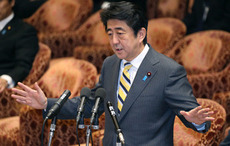 Source: asahi.com
Source: asahi.com Given the increase in consumption tax scheduled to begin from April 8th this year (which may account for a brief spike in consumer spending), the combined effects of a still sluggish global economy, a weaker Japanese yen, weaker demand for Japanese products, and cautious domestic spending signals difficult days ahead for Abenomics.
The significance of an increased level of consumption tax is certainly weighing on the average Japanese consumer, with 54% of respondents to this Yomiuri Shimbun poll (J) saying that they believed their household spending would decrease as a consequence of the tax hike. The unpopularity of the tax increase has not had a noticeable effect on the Abe government’s popularity however, with the same poll showing that support remains at 60%, only marginally down from the 62% recorded earlier last month.
Yet with wages not expected to grow beyond 0.4%, the effect of increased consumption tax could take further steam out of domestic demand, which may be positive in terms of keeping a lid on Japan’s burgeoning deficit but which will prove a drag on growth. According to an NHK poll taken earlier this month, 49% of respondents did not think that the economic recovery spurred by Abenomics was personally benefitting them, with 15% answering that is was and 34% undecided (J). While PM Abe may have called on private industry to increase wages as a necessary condition to ensure the continuation of a 2% inflation rate (J), business may not be convinced as to the wisdom of doing this while growth remains so modest (despite Yomiuri again using a poll to show that 46% of companies surveyed expected to increase wages over the fiscal year. It should be noted that a predominant number of these businesses are related to the construction industry, a major beneficiary of the ‘second arrow’ in the Abenomics bow – i.e., large scale investment in domestic infrastructure projects (J).
Others have pointed this out on numerous occasions, as have I, but the real test of Abe’s commitment to economic stimulation lies in the third arrow of Abenomics: structural reform. Abe has certainly been pushing for greater trade liberalisation, and is currently pursuing EPAs with a number of countries to help create greater incentives for investment both in Japan and abroad. While preparing the domestic market for foreign investors, Abe has also been calling for changes to employment laws to provide greater certainty for Japan’s large number of non-permanent workers, along with an increase in female workplace participation.
So far, this has mostly amounted to rhetoric with little by way of concrete proposals, and does not really address either the demographic issues facing Japan nor the rigidity of Japan’s labour practices and immigration laws, but as this is the ‘arrow’ with the greatest potential to cure Japan of its economic malaise, one cannot fault Abe for being more cautious with his approach. With issues regarding educational reform, national security, and constitutional revision starting to creep back into the political narrative, there is a risk that economic priorities will be sidelined in favour of debate on the LDP’s pet subjects and that fiscal reform will start and end with EPAs. If economic growth is to occur it needs the third arrow as much if not more than the previous two, and some solid determination from Abe not to allow traditional vested interests (i.e the construction industry) to hijack the entire process of reform. So far so good, but there is a long way to go.
 RSS Feed
RSS Feed